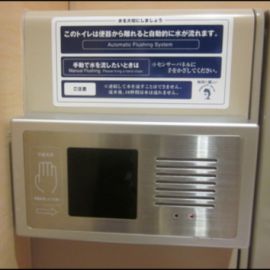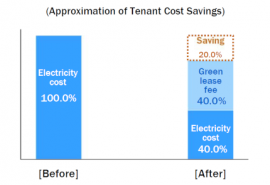Environmental Initiatives
We have set targets for greenhouse gas (CO₂) emissions, energy consumption, water consumption, etc., and seek to meet these targets through improvement of building management, capital investment, energy efficiency training for tenants, property managers, etc. and other initiatives.
Set Targets
■ Greenhouse Gas (CO₂) Emissions
- 42% reduction in greenhouse gas (CO₂) emissions (Scope 1 and 2) intensity by FY2030 (vs. FY2020)
- Achieving net zero greenhouse gas (CO₂) emissions (Scope 1, 2, and 3 total emissions) by FY2050
■ Energy Consumption
- To reduce intensity for the entire portfolio by 1% every year
■ Water Consumption
- To reduce intensity for the entire portfolio to not exceed that of the previous fiscal year every year
Performance Data
■ Greenhouse Gas (CO₂) Emissions
| Fiscal Year | 2020 (Base Year) |
2021 | 2022 |
|---|---|---|---|
| Absolute Emissions (Scope1,2) (t-CO₂) |
9,292 | 7,579 | 7,736 |
| Emissions Intensity(Scope1,2) (Kg-CO₂/㎡) |
80.6 | 58.3 | 57.4 |
| Emissions Intensity(Scope1,2) Reduction Rate |
- | 27.7% | 28.8% |
| (Note 1) | Performance data is based on the amount consumed in the common areas of properties managed by NUD. In addition, for co-ownership properties, the figures are adjusted according to the ownership ratio. Intensity is calculated by dividing the annual emission volume by intensity denominator (annual average floor area of common area [㎡] after ownership interest conversion) |
|---|---|
■ Energy Consumption
| Fiscal Year | 2021 | 2022 | Year on Year |
|---|---|---|---|
| Absolute Consumption (MWh) | 75,074 | 75,768 | 100.9% |
| Consumption Intensity (MWh/㎡) | 0.169 | 0.165 | 97.5% |
| (Note 1) | The figures are adjusted according to the ownership ratio for co-ownership properties. Intensity is calculated by dividing the annual consumption volume by intensity denominator (annual average total floor area [㎡] after ownership interest conversion) |
|---|---|
■ Water Consumption
| Fiscal Year | 2021 | 2022 | Year on Year |
|---|---|---|---|
| Absolute Consumption (㎥) | 140,535 | 138,909 | 98.8% |
| Consumption Intensity (㎥/㎡) | 0.494 | 0.463 | 93.6% |
| (Note 1) | Performance data is based on the amount consumed in office buildings managed by NUD. In addition, for co-ownership properties, the figures are adjusted according to the ownership ratio. Intensity is calculated by dividing the annual consumption volume by intensity denominator (annual average total floor area [㎡] after ownership interest conversion) |
|---|---|
■ Waste Emissions
| Fiscal Year | 2021 | 2022 | Year on Year |
|---|---|---|---|
| Absolute Emissions(t) | 804 | 1,064 | 132.3% |
| (Note 1) | Performance data is based on the amount consumed in the common areas and tenant areas of office buildings managed by NUD. In addition, for co-ownership properties, the figures are adjusted according to the ownership ratio. Due to improved coverage rate, the emissions in FY2022 are significantly higher than in FY2021. |
|---|
Examples of Initiatives
■ Switching Lighting to LED
Switching lighting in common areas, rental units, etc. of portfolio properties to LED in view of environmental consideration and cost reduction.
As of October 31, 2023
introduced at
58 properties out of 59
■ Introduction of Water-Efficient Equipment
Introducing water-efficient equipment at portfolio properties in view of environmental consideration and cost reduction.
As of October 31, 2023
introduced at
53 properties out of 59

■ Introduction of Green Leasing
“Green lease” is an arrangement providing for the promotion of energy efficiency and environmental consideration by both the building owner and tenant sides through building lease agreements. At NUD, initiatives include switching lighting in tenants’ exclusive areas to LED with the understanding of the tenants.
As of October 31, 2023
introduced at
10 properties out of 59

■ Introduction of renewable energy
Promoting the introduction of renewable energy to reduce CO₂ emissions.
As of October 31, 2023
introduced at
20 properties out of 59